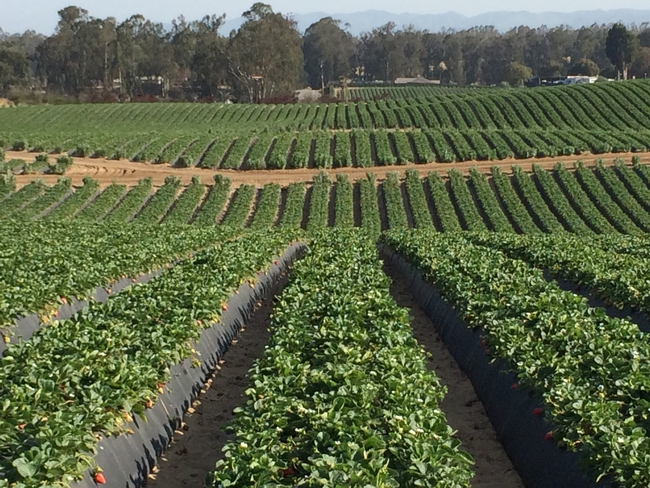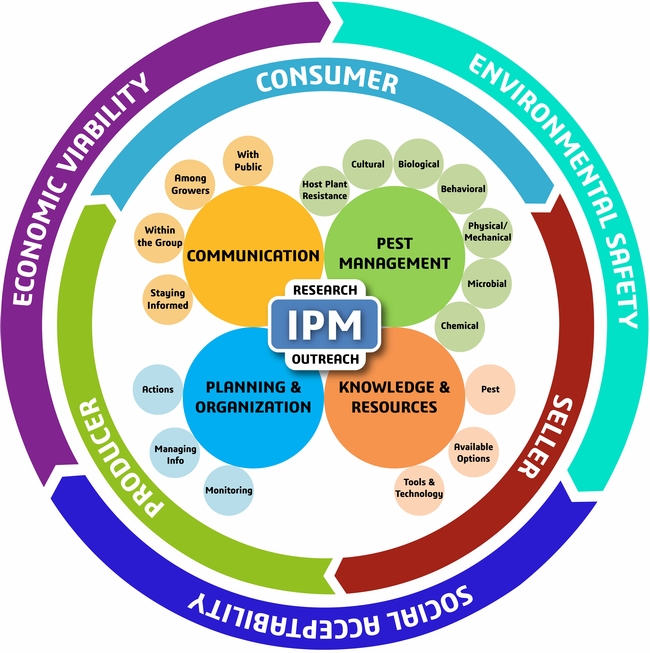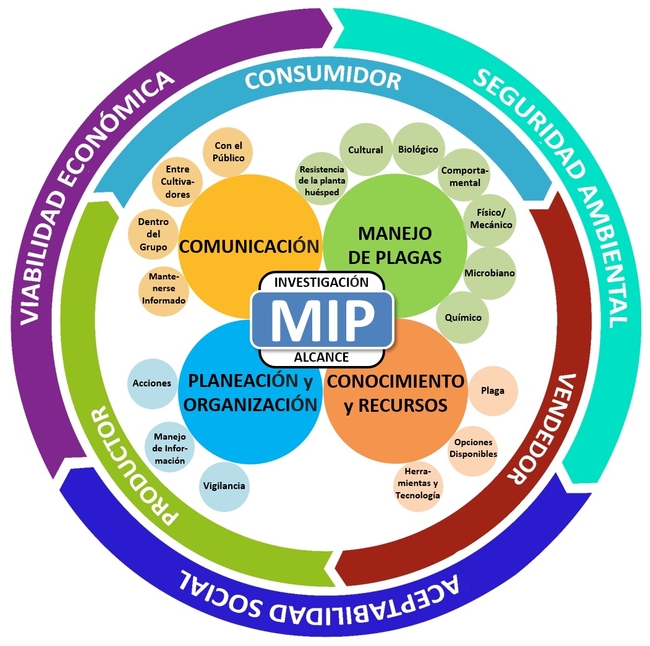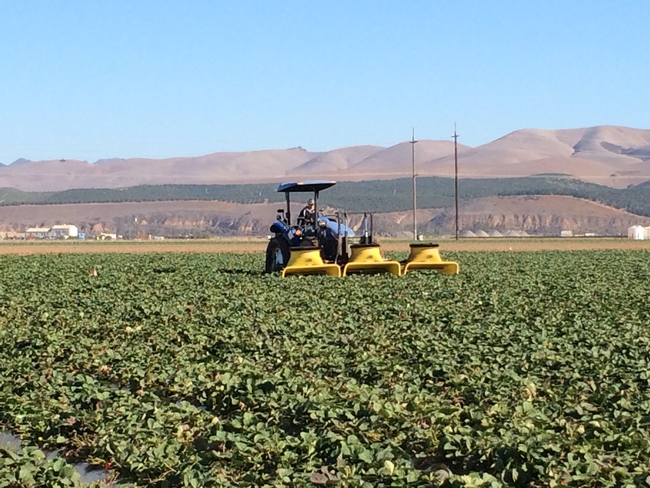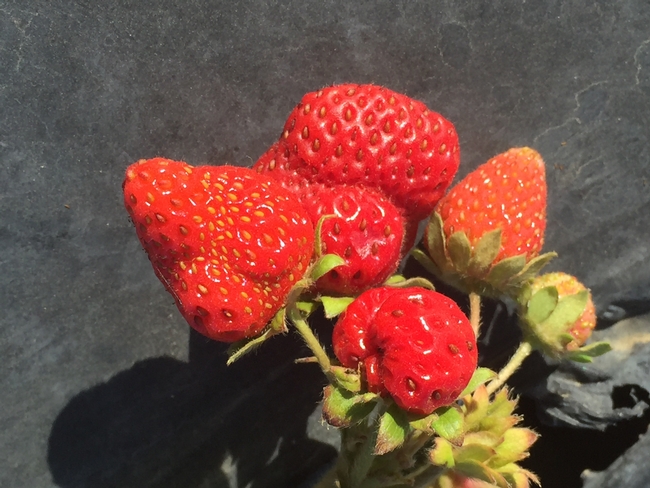The traditional Integrated Pest Management (IPM) model is focused on maintaining ecological balance in the cropping system with some attention to the economics of pest management related to the yield losses. The new model, recently published in the Journal of Integrated Pest Management, is more comprehensive covering the management, business, and sustainability aspects of pest management and discusses various components within (Dara, 2019). IPM, according to the new model, can be defined as an approach to managing pests in an economically viable, socially acceptable, and environmentally safe manner.
New IPM model from Dara, 2019
Based on the information generated by several studies in California and other reports, here is how the new IPM model can be adapted for producing strawberries sustainably.
1. MANAGEMENT ASPECT
A. Pest Management: The term “pest” includes arthropod pests, diseases, and weeds and the management includes the various practices used to suppress them.
- Select varieties that produce good yields while resisting biotic and abiotic stresses.
- Choosing the right mulch and good irrigation and nutrient management contribute to good plant growth and health. Micro-sprinklers save water and hold pest management benefits.
- Explore the potential of beneficial microbes and biostimulants to improve nutrient and water absorption and to maintain crop health. Inoculate the transplants with biostimulants to induce systemic resistance and periodically apply, especially after fumigation, to improve the beneficial microbial activity in the soil.
- Healthy plants resist pest problems and reduce the need for control options. Plant health can be maintained through good cultural practices (biostimulants, nutrients, irrigation, soil conditioning, etc.).
- Predatory mites effectively control twospotted and Lewis mites, but natural enemy populations may not be sufficient to control the western tarnished plant bug.
- Light traps can be useful for managing lepidopteran pests.
- Tractor-mounted vacuums can be a part of the IPM program for managing the western tarnished plant bug, but their pest control efficiency is not necessarily superior to other strategies and are not without some associated risks. For example, operation of vacuums requires fossil fuels and they are used at a much higher frequency than pesticide applications.
- Use botanical, microbial, and chemical pesticides in combination. Combinations can improve pest control efficacy and rotations reduce the risk of resistance development.
- Rotating strawberries with crops such as broccoli can reduce the severity of certain soilborne diseases.
B. Knowledge and Resources:
- Understand pest biology, vulnerable stages of the pest, and appropriate strategies for each pest, different life stages, season, and budget. For example, relying on natural enemies for the western tarnished plant bug control is not effective and can lead to higher pest damage.
- Accurately identify the issue through visual observation or laboratory diagnosis for proper corrective action.
- Try to explore modern technology to monitor crop health.
C. Planning and Organization:
- Regularly monitor crop health for early detection and prevention of potential pest problems. For example, thorough scouting to determine the level of western tarnished plant bug infestation is very important for making the treatment decision. Deformed fruit is not always an indicator for the treatment threshold as nearly 1/3 of the fruit deformity occurs from environmental and other causes not related to the western tarnished plant bug.
- Look for signs of pesticide resistance and use appropriate strategies to reduce the risk.
- Maintain records of pest occurrence, seasonal trends, strategies that worked, and all relevant information, to build institutional knowledge for future use.
- Take the right action at the right time.
D. Communication:
- Regularly attend extension events and read research updates. Choose or design practices that are ideal for your farm based on the research updates.
- Periodically provide training to all individuals on the farm who directly or indirectly contribute to good agriculture practices.
- Share good management practices with each other for area-wide improvement of crop production and pest management.
- Try to educate the public so that they make better choices when purchasing produce. For example, good IPM practices can be more sustainable than organically approved practices and well-informed consumers can make a choice among conventional, organic, or sustainably produced grains, fruits, and vegetables. Public education can also help to eliminate otherwise good produce that is discarded because of minor imperfections. In strawberry, fruit deformity is caused due to the feeding of the western tarnished plant bug, genetic factors, poor pollination, or very low temperatures. Although most of the deformed strawberries, especially those from insect damage, have equal quality as marketable strawberries, they are discarded because of their shape. If the consumer market can accept deformed strawberries that still have good taste and nutritional quality, it can significantly reduce the wastage and the amount of pesticides sprayed to control the western tarnished plant bug.
2. BUSINESS ASPECT
- A strong IPM program can help growers produce sustainably while ensuring profitability.
- Consumer choices depend on their knowledge of sustainable agriculture. When they understand that produce with an IPM or Sustainably Produced label is safe for human and environmental health, it will have a major impact on food production systems.
3. SUSTAINABILITY ASPECT
- The current interpretation or perception of sustainability does not reflect true sustainability in terms of environmental health, profitability, food security, social equality, and other elements. A good IPM model can address all these issues to ensure farm productivity, food affordability, and environmental safety.
RESEARCH and OUTREACH
- Research and outreach component is the foundation of IPM to identify pest issues, develop appropriate knowledge for their management, and effectively disseminate the related information. Supporting research and outreach efforts of universities and other entities is essential for continuing IPM.
References
In addition to the below references, there are several articles in this eJournal on crop production and protection topics related to strawberry.
- Download “Biology and management of spider mites in strawberry” in English and Spanish at http://ucanr.edu/spidermiteguide or scan the QR code. Information about different species of spider mites and predatory mites is available in this guide.
- Efficacy of botanical, chemical, and microbial pesticides on twospotted spider mite and their impact on predatory mites //ucanr.edu/blogs/blogcore/postdetail.cfm?postnum=18553
- Entomopathogenic fungi can endophytically colonize strawberry plants when applied to the soil and negatively impact twospotted spider mite infestations //ucanr.edu/blogs/blogcore/postdetail.cfm?postnum=16821
- How to detect resistance to miticides in twospotted spider mite populations and strategies to reduce the resistance development //ucanr.edu/blogs/blogcore/postdetail.cfm?postnum=22097
- Comparison between the twospotted spider mite and the Lewis mite //ucanr.edu/blogs/blogcore/postdetail.cfm?postnum=5771
- An overview of lygus bug biology, damage, and management in strawberries http://cesantabarbara.ucanr.edu/files/75473.pdf
- Lygus biology, monitoring, and management videos http://ucanr.edu/SDYouTube
- Fruit deformity in strawberry from lygus bug and other factors //ucanr.edu/blogs/blogcore/postdetail.cfm?postnum=19630
- Potential of a solar-powered UV light trap as a pest management option in strawberry //ucanr.edu/blogs/blogcore/postdetail.cfm?postnum=25307
- IPM tools for controlling western tarnished plant bug in strawberry https://ucanr.edu/blogs/blogcore/postdetail.cfm?postnum=19641
- Entomopathogens (pathogens of insects, mites, and ticks), their modes of infection, and how they can be used as a powerful tool in IPM //ucanr.edu/blogs/blogcore/postdetail.cfm?postnum=24119
- Biopesticides and IPM https://ucanr.edu/blogs/blogcore/postdetail.cfm?postnum=25912
- Lygus bug and natural enemy populations in organic and conventional strawberries https://ucanr.edu/blogs/blogcore/postdetail.cfm?postnum=14030
- Microbial and bioactive soil amendments for improving strawberry health and yields (2017-2018 study) https://ucanr.edu/blogs/blogcore/postdetail.cfm?postnum=27891
- Beneficial microbe-based products for strawberry health and yield (2016-2017 study)
https://ucanr.edu/blogs/blogcore/postdetail.cfm?postnum=25122
- Beneficial microbes and entomopathogenic fungi for strawberry health and yield (2015-2016 study) https://ucanr.edu/blogs/blogcore/postdetail.cfm?postnum=22709
- Entomopathogenic fungi antagonizing Macrophomina phaseolina https://ucanr.edu/blogs/blogcore/postdetail.cfm?postnum=28274
- Entomopathogenic fungi and other biologicals against Fusarium oxysporum
https://ucanr.edu/blogs/blogcore/postdetail.cfm?postnum=22199
- Micro-sprinklers in strawberry https://ucanr.edu/blogs/blogcore/postdetail.cfm?postnum=19699
